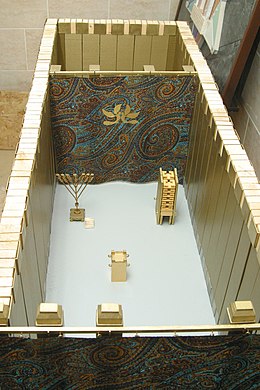
The Holy of Holies (Hebrew: קֹדֶשׁ הַקֳּדָשִׁים, romanized: Qōḏeš haqQŏḏāšīm or Kodesh HaKodashim; also הַדְּבִיר hadDəḇīr, 'the Sanctuary') is a term in the Hebrew Bible that refers to the inner sanctuary of the Tabernacle, where the Shekhinah (God's presence) appeared. According to Hebrew tradition, the area was defined by four pillars that held up the veil of the covering, under which the Ark of the Covenant was held above the floor. According to the Hebrew Bible, the Ark contained the Ten Commandments, which were given by God to Moses on Mount Sinai. The first Temple in Jerusalem, called Solomon's Temple, was said to have been built by King Solomon to keep the Ark.
Ancient Jewish traditions viewed the Holy of Holies as the spiritual junction of Heaven and Earth, the "axis mundi".
As a part of the Jewish Temple in Jerusalem, the Holy of Holies was situated somewhere on Temple Mount; its precise location in the Mount being a matter of dispute, with some classical Jewish sources identifying its location with the Foundation Stone, which sits under the Dome of the Rock shrine. Other Jewish scholars argue that contemporary reports would place the Temple to the north or to the east of the Dome of the Rock.
The Christian Crusaders associated the Holy of Holies with the Well of Souls, a small cave that lies underneath the Foundation Stone in the Dome of the Rock.
Hebrew terminology and translation

The construction "Holy of Holies" is a translation of the Hebrew, which is intended to express a superlative. Examples of similar constructions are "servant of servants" (Gen 9:25), "Sabbath of sabbaths" (Ex 31:15), "God of gods" (Deut 10:17), "Vanity of vanities" (Eccl 1:2), "Song of songs" (Song of Songs 1:1), "king of kings" (Ezra 7:12), etc.
In the Authorized King James Version, "Holy of Holies" is always translated as "Most Holy Place". This is in keeping with the intention of the Hebrew idiom to express the utmost degree of holiness. Thus, the name "Most Holy Place" was used to refer to the "Holy of Holies" in many English documents.
A related term is debir, transliterated in the Septuagint (Koinē Greek: δαβιρ, romanized: dabir), which either means the back (i.e. western) part of the Sanctuary, or derives from the verb stem ד־ב־ר "to speak", justifying the translation in the Vulgate as oraculum, which the traditional English translation "oracle" (KJV, 1611) derives from.
Ancient Israel
Tabernacle
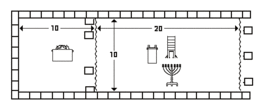
According to the Hebrew Bible, in order that God may dwell among the Israelites, God gave Moses instructions for erecting a sanctuary. The directions provide for:
- A wooden ark, gilded inside and outside, for the Tablets of the Covenant, with a pure gold cover as the "mercy seat" for the Divine Presence;
- A gilt table for the "Table of Showbread", on which loaves of bread were arranged;
- A golden menorah, lampstand of 7 oil lamps for a light never to be extinguished;
- The dwelling, including the curtains for the roof, the walls made of boards resting on silver feet and held together by wooden bolts, the multi-colored curtain veiling the Holy of Holies (of blue, purple, crimson, white and gold), the table and candlestick, and the outer curtain;
- A sacrificial altar made of bronzed boards for its korban/sacrifice;
- The outer court formed by pillars resting on bronze pedestals and connected by hooks and crossbars of silver, with embroidered curtains;
- Recipe and preparation of the oil for the Lampstand.
According to the Bible, the Holy of Holies was covered by a veil, and no one was allowed to enter except the High Priest, and even he would only enter once a year on Yom Kippur, to offer the blood of sacrifice and incense. The Bible reports that in the wilderness, on the day that the tabernacle was first raised up, the cloud of the Lord covered the tabernacle (Exodus 40:33–40:34). There are other times that this was recorded, and instructions were given that the Lord would appear in the cloud upon the mercy seat (kapporet), and at that time the priests should not enter into the tabernacle (Leviticus 16:2). According to the Hebrew Bible, the Holy of Holies contained the Ark of the Covenant with representation of Cherubim.
Upon completion of the dedication of the Tabernacle, the Voice of God spoke to Moses "from between the Cherubim" (Numbers 7:89).
Solomon's Temple
Main article: Solomon's TempleThe Holy of Holies was the inner sanctuary within the Tabernacle and Temple in Jerusalem when Solomon's Temple and the Second Temple were standing. The parochet, a brocade curtain with cherubim motifs woven directly into the fabric from the loom, divided the Holy of Holies from the lesser Holy place.
The Holy of Holies was located at the westernmost end of the Temple building and was a cube: 20 cubits by 20 cubits by 20 cubits. The inside was in darkness and contained the Ark of the Covenant, gilded inside and out, in which was placed the Tablets of Stone. According to both Jewish and Christian traditions, Aaron's rod and a pot of manna were also in the ark. The Ark was covered with a lid made of pure gold, known as the "mercy seat" (Exodus 37:6), which was covered by the beaten gold cherubim wings, creating the space for the Shekhinah (Exodus 25:22).
Second Temple
Main article: Second Temple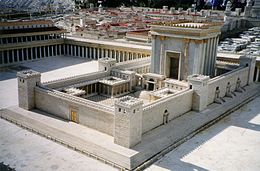
When the Temple was rebuilt after the Babylonian captivity, the Ark was no longer present in the Holy of Holies; instead, a portion of the floor was raised slightly to indicate the place where it had stood. In Jewish tradition, two curtains separated the Holy of Holies from the lesser Holy place during the period of the Second Temple. These curtains were woven with motifs directly from the loom, rather than embroidered, and each curtain had the thickness of a handbreadth (ca. 9 cm.; 3½"). Josephus records that Pompey profaned the Temple by insisting on entering the Holy of Holies in 63 BCE. When Titus captured the city during the First Jewish–Roman War, Roman soldiers took down the curtain and used it to wrap therein golden vessels retrieved from the Temple.
Yom Kippur
Main article: Yom Kippur Temple serviceThe Holy of Holies was entered once a year by the High Priest on Yom Kippur, to sprinkle the blood of sacrificial animals (a bull offered as atonement for the Priest and his household, and a goat offered as atonement for the people (this is where the term scapegoat originates from)) and offer incense upon the Ark of the Covenant and the mercy seat that sat on top of the ark in the First Temple (the Second Temple had no ark and the blood was sprinkled where the Ark would have been and the incense was put on the Brazen Altar of incense). The animal was sacrificed and the blood was carried into the most holy place. The gold was also found in the Most Holy Place.

In ancient Judaism
The Magdala stone is thought to be a representation of the Holy of Holies carved before the destruction of the Temple in the year 70.
In Rabbinical Judaism
Traditional Judaism regards the location where the inner sanctuary was originally located, on the Temple Mount (Mount Moriah), as retaining some or all of its original sanctity for use in a future Third Temple. The exact location of the Holy of Holies is a subject of dispute.
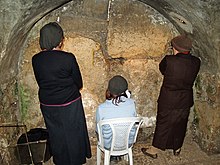
Traditional Judaism regards the Holy of Holies as the place where the presence of God dwells. The Talmud gives detailed descriptions of Temple architecture and layout. According to the Babylonian Talmud Tractate Yoma, the Kodesh Hakodashim (Holy of Holies) is located in the center of the esplanade from a North–South perspective, but significantly to the West from an East–West perspective, with all the major courtyards and functional areas lying to its east.
The Talmud supplies additional details, and describes the ritual performed by the High Priest. During the annual ritual, the High Priest would pronounce the Tetragrammaton, the only point that it was pronounced out loud. According to Jewish tradition, the people prostrated themselves fully on the ground when it was said. According to the Talmud, the High Priest's face upon exit from the Holy of Holies was radiant.
While under normal circumstances, access to the Holy of Holies was restricted to the High Priest and only on Yom Kippur, the Talmud suggests that repair crews were allowed inside as needed but were lowered from the upper portion of the room via enclosures so that they only saw the area they were to work on.
Synagogue architecture
Judaism regards the Torah ark, a place in a synagogue where the Torah scrolls are kept, as a miniature Holy of Holies.
Modern location
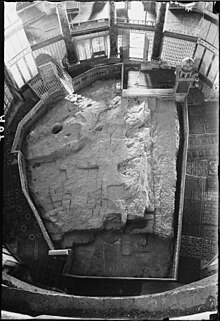
The exact location of the Holy of Holies is a contentious issue, as elements of questioning the exact placement of the Temple are often associated with Temple denial. There are three main theories as to where exactly the Temple stood on the Mount: where the Dome of the Rock is now located; to the north of the Dome of the Rock (Professor Asher Kaufman); or to the east of the Dome of the Rock (Professor Joseph Patrich of the Hebrew University).
The location of the Holy of Holies is connected to the location of the Jewish Temple. The location of the Temple, however, had become uncertain already less than 150 years after the Second Temple's destruction, as detailed in the Talmud. Chapter 54 of the Tractate Berakhot states that the Holy of Holies was directly aligned with the Golden Gate, which, assuming the current gate follows the same course as the now buried Herodian gate, would have placed the Holy of Holies slightly to the north of the Dome of the Rock, as Kaufman postulated. Chapter 54 of the Tractate Yoma and chapter 26 of the Tractate Sanhedrin, on the other hand, assert that the Holy of Holies stood directly on the Foundation Stone.
The Crusaders associated the Holy of Holies with the Well of Souls, which is located under the Foundation Stone of the Dome of the Rock. Most Orthodox Jews today completely avoid climbing up to Temple Mount, to prevent them from accidentally stepping on any holy areas. A few Orthodox Jewish authorities, following the opinion of the medieval scholar Maimonides, permit Jews to visit parts of the Temple Mount known not to be anywhere near any of the sanctified areas. Orthodox Jewish visitors to the Temple Mount, who come especially from those groups associated with the Temple Institute and its efforts to rebuild a Temple, seek to conform to the minimal requirements for coming near the Temple, such as immersing in a mikvah ("collection of water"; a ritual of purification), not coming during or following menstruation or immediately following a seminal emission, not showing their back towards its presumed location, etc.
To avoid religious conflict, Jewish visitors caught praying or bringing ritual objects are usually expelled from the area by police.
In apocryphal literature
According to the ancient apocryphal Lives of the Prophets, after the death of Zechariah ben Jehoiada, the priests of the Temple could no more, as before, see the apparitions of the angels of the Lord, nor could make divinations with the Ephod, nor give responses from the Debir.
Christianity
New Testament
The Greek New Testament retains the pre-Christian Septuagint phrase "Holy of the Holies" hágion (sg n) tōn hagíōn (ἅγιον τῶν ἁγίων) without the definite article as "Holies of Holies" hágia (pl n) hagíōn (ἅγια ἁγίων) in Hebrews 9:3. In the Vulgate of Saint Jerome, these are rendered as sanctum sanctorum and sancta sanctorum, respectively. The Greek language was the common language upon Hellenization of much of the Middle East after the death of Alexander the Great, and the division of his empire among four generals. The Jews of the Diaspora spoke it; the Vulgate was a faithful translation for Christian Rome.
Christian traditions
Certain branches of Christianity, including the Eastern Orthodox Church, and the Ethiopian Orthodox Tewahedo Church continue to have a tradition of a Holy of Holies that they regard as a most sacred site. The ciborium, a permanent canopy over the altar in some churches, once surrounded by curtains at points in the liturgy, symbolizes the Holy of Holies. Some Christian churches, particularly the Catholic Church, consider the Church tabernacle, or its location (often at the rear of the sanctuary), as the symbolic equivalent of the Holy of Holies, due to the storage of consecrated hosts in that vessel.
Catholic Church
The Latin Vulgate Bible translates Qṓḏeš HaqQŏḏāšîm as Sanctum sanctorum (Ex 26:34). Reproducing in Latin the Hebrew construction, the expression is used as a superlative of the neuter adjective sanctum, to mean "a thing most holy". It is used by Roman Catholics to refer to the Eucharist in the tabernacle which represents the presence of Christ.
The Vulgate also refers to the Holy of Holies with the plural form Sancta sanctorum (2 Chr 5:7), possibly a synecdoche referring to the holy objects hosted there. This form is also used more broadly in Catholic tradition with reference to sanctuaries other than the Temple in Jerusalem. A notable example is for the Chiesa di San Lorenzo in Palatio ad Sancta Sanctorum, a chapel in the complex of St John Lateran in Rome.
Eastern Orthodox Church
Main article: iconostasisThe Greek phrase refers to the Tabernacle or Temple. The name in Greek for the sanctuary of a church is Ἱερόν Βῆμα (Hieron Vema, see Bema#Christianity), in Russian it is called Святой Алтарь (Svyatoy Altar – literally: "Holy Altar"), and in Romanian it is called Sfântul Altar.
Ethiopian Orthodox Tewahedo Church
A cognate term in Ge'ez is found in the Ethiopian Orthodox Tewahedo Church: Qidduse Qiddusan (or Bete Mekdes), referring to the innermost sanctuary of an Orthodox Christian church, where the tabot is kept and only clergy may enter. Every Ethiopian Orthodox church has one, and it is covered with a curtain. There are often three entry points, symbolising the Holy Trinity. In the middle, there is always an altar where the church's tabot is kept. There can be as many altars as the number of tabots.
Malabar Nasrani tradition
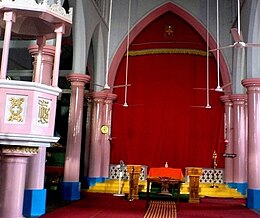
The Saint Thomas Christians (also known as Nasrani or Syrian Christians) from Kerala, South India still follow much Jewish Christian tradition. In Nasrani tradition the Holy of Holies is kept veiled for much of the time. The red veil covers the inner altar or the main altar. It is unveiled only during the central part of the main Nasrani ritual. The main ritual of the Saint Thomas Christians is the Qurbana.
The Church of Jesus Christ of Latter-day Saints
Main article: Holy of Holies (LDS Church)The Salt Lake Temple of the Church of Jesus Christ of Latter-day Saints (LDS Church) contains a Holy of Holies wherein the church's president—acting as the Presiding High Priest—enters to fulfill the relationship between the High Priest of Israel and God in accordance with the LDS Church's interpretation of the Book of Exodus (Exodus 25:22) and Latter-day Saint religious texts.
Seventh-Day Adventist Church
Seventh-Day Adventism (SDA) believes that the Holy of Holies on Earth was a copy of the true tabernacle in heaven, and this view can also be seen in other Christian denominations. Because in Hebrews, God commands Moses to make sure that all things according to the pattern shewed to thee in the Mount Sinai (Heb 8:2, 5). After the "Great Disappointment", preacher O. R. L. Crosier, Hiram Edson, and F. B. Hahn published new insights into Christ's sanctuary ministry that Jesus began to minister in the heavenly sanctuary after His ascension (Heb 9:24). Seventh-Day Adventism (SDA) believes that just as the high priest completed the special ministry on Yom Kippur and blessed the Israelites. Christ will come and bless his people after cleaning the Holy of Holies in heaven (Heb 9:23).
See also
- Honden, the most sacred building at a Shinto shrine
- Lustral basin
- Most Holy Place, in various religions
- Warren's Gate, an ancient entrance into the Temple platform in Jerusalem
References
- ^ "Yoma 54b:2". www.sefaria.org.
- ^ "Sanhedrin 26b:5". www.sefaria.org.
- ^ See article in the World Jewish Digest, April 2007.
- ^ Ritmeyer, Kathleen (1 January 2006). Secrets of Jerusalem's Temple Mount. Biblical Archaeology Society. p. 104. ISBN 9781880317860.
- "H1687 – dᵊḇîr – Strong's Hebrew Lexicon (kjv)". Blue Letter Bible.
- The Solomonic Debir according to the Hebrew Text of I Kings 6 J. Ouellette – Journal of Biblical Literature, 1970 – JSTOR "The immediate implication of this reading is that the holy of holies was built "from within the debir," that is ... The LXX simply transliterates dabir, while the Vulgate has "oraculum", thus suggesting a derivation from dbr "to speak."
- The Damaged "blueprints" of the Temple of Solomon. L. Waterman – Journal of Near Eastern Studies, 1943 – JSTOR "The term "holy of holies" has long been accepted as a later descriptive term applied to the debir. The Hebrew word debir, rendered "oracle" in the versions, is a mistranslation based on a false etymology. The term itself signifies only the back or part behind, for example."
- Exodus 26:31–33.
- Leviticus 16
- Babylonian Talmud (Yoma 72b); Rashi's Commentary and Aramaic Targum of Exodus 26:31. The "parochet" was "the work of an artisan," meaning, one who was skilled in motifs worked into the loom. Brocade refers to the decorative elements inserted into the weft on the loom, unlike embroidery that is added to the finished cloth.
- Midrash Rabba, Midrash HaGadol, et al.; Hebrews 9:4 in the New Testament
- Midrash HaGadol on Exodus 26:31; Babylonian Talmud (Yoma 72b)
- "The War of the Jews" – via Wikisource.
- Kershner, Isabel (8 December 2015). "A Carved Stone Block Upends Assumptions About Ancient Judaism". The New York Times. Retrieved 9 December 2015.
- Talmud Mas. Pesachim 26a
- Talmud Mas. Eiruvin 105a
- "Berakhot 54a:7". www.sefaria.org.
- Sidra DeKoven Ezrahi, Bernard Avishai, 'Jews Don’t Have a ‘Holiest’ Site,' Haaretz 13 May :’The point is, this kind of recklessness not only offended secular democrats, it vulgarized what “holy” has meant for most observant Jews, too. Not coincidentally, more than 85 percent of Israel’s Haredi Jews oppose prayer on the Mount, for reasons having to do with purity and impurity that cannot be resolved in “our time.” Advocates of such prayer and sacrifice tend to be, like Goren, Orthodox-nationalist zealots educated in local yeshivas and identified with the neo-Zionist settlement project. They are, like Islamists, fanatics warped by violence and nationalist fantasy – “Jewists,” not Jews.‘
- Shragai, Nadav (1 September 2003). "Three Jews Expelled from Temple Mount for Praying". Haaretz. Retrieved 12 April 2017.
- "The Lives of the Prophets – Zechariah son of Jehoiada". Archived from the original on 2016-03-01. Retrieved 2016-03-01.
- Olley, John W. (2009). Ezekiel. BRILL. ISBN 978-9004177130.
- "New Advent Bible: Hebrews 9". newadvent.org.
- Stuart C. Munro-Hay, Ethiopia, the unknown land: a cultural and historical guide, (London, England: I. B. Tauris, 2002). p. 50.
- ^ Ross, Israel J. (1979). "Ritual and Music in South India: Syrian Christian Liturgical Music in Kerala". Asian Music. 11 (1): 80–98.
- ^ Damsteegt, P. Gerard (Fall 1992). "How Our Pioneers Discovered the Sanctuary Doctrine". Andrews University.
- Barker, Margaret (1998). "Beyond the Veil of the Temple: The High Priestly Origins of the Apocalypses". Scottish Journal of Theology. 51 (1): 1–21. doi:10.1017/s0036930600049991. ISSN 0036-9306. S2CID 170375914.
- "Christ's ministry in the Heavenly Sanctuary". General Conference of Seventh-day Adventists. Retrieved 2019-10-17.
| Temple Mount / Al-Aqsa | |||||||||||||
|---|---|---|---|---|---|---|---|---|---|---|---|---|---|
| Al-Aqsa |
| ||||||||||||
| Jewish elements |
| ||||||||||||
| Other components |
| ||||||||||||
| Excavations | |||||||||||||
| Conflicts | |||||||||||||
| See also | |||||||||||||
| Ark of the Covenant topics | |
|---|---|
| People | |
| Lid | |
| Contents | |
| Locations | |
| Related |
|
| Holy places in Judaism | |||||||||
|---|---|---|---|---|---|---|---|---|---|
| Holy Land |
| ||||||||
| Tombs of biblical figures |
| ||||||||
| Temples in Jewish history | ||||||
|---|---|---|---|---|---|---|
| Temples and other sites |
|   | ||||
| Related topics |
| |||||